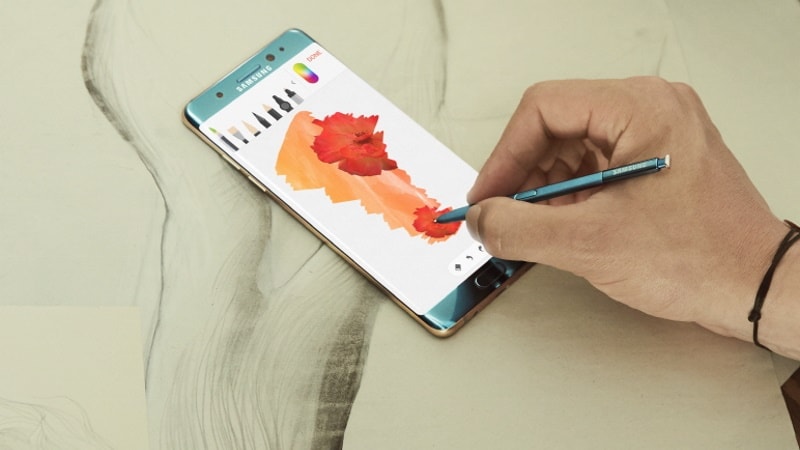- Home
- Mobiles
- Mobiles Features
- Why Those Samsung Galaxy Note 7 Batteries Exploded
Why Those Samsung Galaxy Note 7 Batteries Exploded

Lithium ion batteries show up in all sort of tech these days, from your phone and laptop to airplanes and electric vehicles. But a voluntary recall of some 2.5 million Samsung Galaxy Note 7 smartphones after reports of battery explosions is raising new concerns about their safety.
Last week the Federal Aviation Authority warned passengers not to turn on or charge the devices during flights - or even put them in checked baggage. Some international airlines have placed similar restrictions on traveling with the smartphone. And the US Consumer Product Safety Commission advised consumers "to stop charging or using the device."
(Also see: Samsung Galaxy Note 7 May Go Down as the Worst Smartphone Ever: Analyst)
Here's what you need to know about the lithium batteries that probably power a lot of your tech - and why they sometimes catch fire.
What are lithium ion batteries, and why are they so popular?
Lithium ion batteries are a bit different from the basic AA's you use to power your TV remote. They're rechargeable, often built directly into devices and rely on the chemical lithium as their primary fuel.
Lithium ion batteries are especially popular in devices such as laptops and phones, because they store energy super efficiently and are slow to lose their charge.
(Also see: Samsung Galaxy Note 7 Recall May Cost Company as Much as $1 Billion)
"You get a lot of oomph relative to older technologies that were the same size - often two to four times the voltage," explained Stephen Hackney, a professor of materials science and engineering at Michigan Tech University.
(Also see: Samsung Galaxy Note 7 Recall: Here's How to Check If Your Unit Is Safe)
How do they work?
Like pretty much all batteries, lithium ion batteries work by storing energy and releasing it through controlled chemical reactions. A lithium ion battery has two electrodes - places where electricity can enter or leave the battery - on opposite sides. One electrode, called the anode, is filled with negatively charged ions. The other electrode, called a cathode, contains positively charged ions and lithium. You can think of the anode and the cathodes like the plus and minus signs you often see on batteries.
(Also see: Now, Samsung Reportedly Hit With a Lawsuit About an Exploding Galaxy S7 Edge)
When you use a battery, the lithium moves over from the cathode to the anode - and when you charge it, the lithium moves back over to the cathode. There's a separator inside that keeps the anode and the cathode from touching because that can trigger mishaps such as fires and explosions.
So, what can cause the explosions?
The reason you can shove so much power into lithium ion batteries is that lithium basically "wants to react to almost anything" - which can lead to explosive results, Hackney said.
But one of the most common reasons the batteries can explode is because of mistakes in the charging process, he said. Inside the devices that rely on the batteries there is software that tells them exactly how much the batteries should be charged and how fast. If those protocols are set incorrectly, it can destabilize some chemicals inside the battery and cause a chain reaction that researchers call a "thermal runaway" that may lead to fire or explosions.
Overheating can also cause explosions, which is why your phone probably pops up with an alert about needing to cool down when it gets too hot.
Another reason could be shoddy manufacturing or rough user treatment. If unwanted materials, like scraps of metal, accidentally end up inside the battery when it's being made, they can short a cell of the battery and set off a thermal runaway. So could dropping a device if the impact causes a break in the separator between the anode and cathode.
What happened with the Galaxy Note 7?
It seems like a manufacturing problem. The company reports at least 35 cases where the batteries combusted due to "a very rare manufacturing process error" in which the anode and cathode touched, the company said in a statement on its UK website.
The company decided to temporarily pull the phone off the market just two weeks after it was released and is offering replacements to people who already purchased the device.
How often do these types of problems occur?
The good news, according to Hackney, is they're pretty uncommon, especially among high-end devices, when manufacturers keep a close eye on production quality.
But there have been plenty of high-profile cases. For instance, back in 2006 Dell recalled more than 4 million laptop battery packs over combustion issues. In 2013, the Boeing 787 Dreamliner was grounded by the FAA after reports of fires related to the lithium ion batteries used in the planes. And half a million hoverboards, one of the hottest gifts of the last holiday season, were recalled this summer because of lithium ion battery explosions.
Are regulators looking into these batteries?
The government and international organizations already regulate lithium ion batteries in a lot of ways, which is probably one of the reasons we don't see more explosions. For example, the Department of Transportation has rules for how to safely ship the batteries.
Other US regulations also call for batteries that end up in consumer goods to go through various safety tests, and the Consumer Product Safety Commission has overseen a lot of recalls involving products with lithium ion batteries that were deemed hazardous. The agency is working with Samsung on a formal Galaxy Note 7 recall in the United States.
© 2016 The Washington Post
Catch the latest from the Consumer Electronics Show on Gadgets 360, at our CES 2026 hub.
Related Stories
- Samsung Galaxy Unpacked 2025
- ChatGPT
- Redmi Note 14 Pro+
- iPhone 16
- Apple Vision Pro
- Oneplus 12
- OnePlus Nord CE 3 Lite 5G
- iPhone 13
- Xiaomi 14 Pro
- Oppo Find N3
- Tecno Spark Go (2023)
- Realme V30
- Best Phones Under 25000
- Samsung Galaxy S24 Series
- Cryptocurrency
- iQoo 12
- Samsung Galaxy S24 Ultra
- Giottus
- Samsung Galaxy Z Flip 5
- Apple 'Scary Fast'
- Housefull 5
- GoPro Hero 12 Black Review
- Invincible Season 2
- JioGlass
- HD Ready TV
- Laptop Under 50000
- Smartwatch Under 10000
- Latest Mobile Phones
- Compare Phones
- OnePlus Turbo 6V
- OnePlus Turbo 6
- Itel Zeno 20 Max
- OPPO Reno 15 Pro Mini 5G
- Poco M8 Pro 5G
- Motorola Signature
- Vivo Y50e 5G
- Vivo Y50s 5G
- Lenovo Yoga Slim 7x (2025)
- Lenovo Yoga Slim 7a
- Realme Pad 3
- OPPO Pad Air 5
- Xiaomi Watch 5
- Huawei Watch 10th Anniversary Edition
- Acerpure Nitro Z Series 100-inch QLED TV
- Samsung 43 Inch LED Ultra HD (4K) Smart TV (UA43UE81AFULXL)
- Asus ROG Ally
- Nintendo Switch Lite
- Haier 1.6 Ton 5 Star Inverter Split AC (HSU19G-MZAID5BN-INV)
- Haier 1.6 Ton 5 Star Inverter Split AC (HSU19G-MZAIM5BN-INV)


















